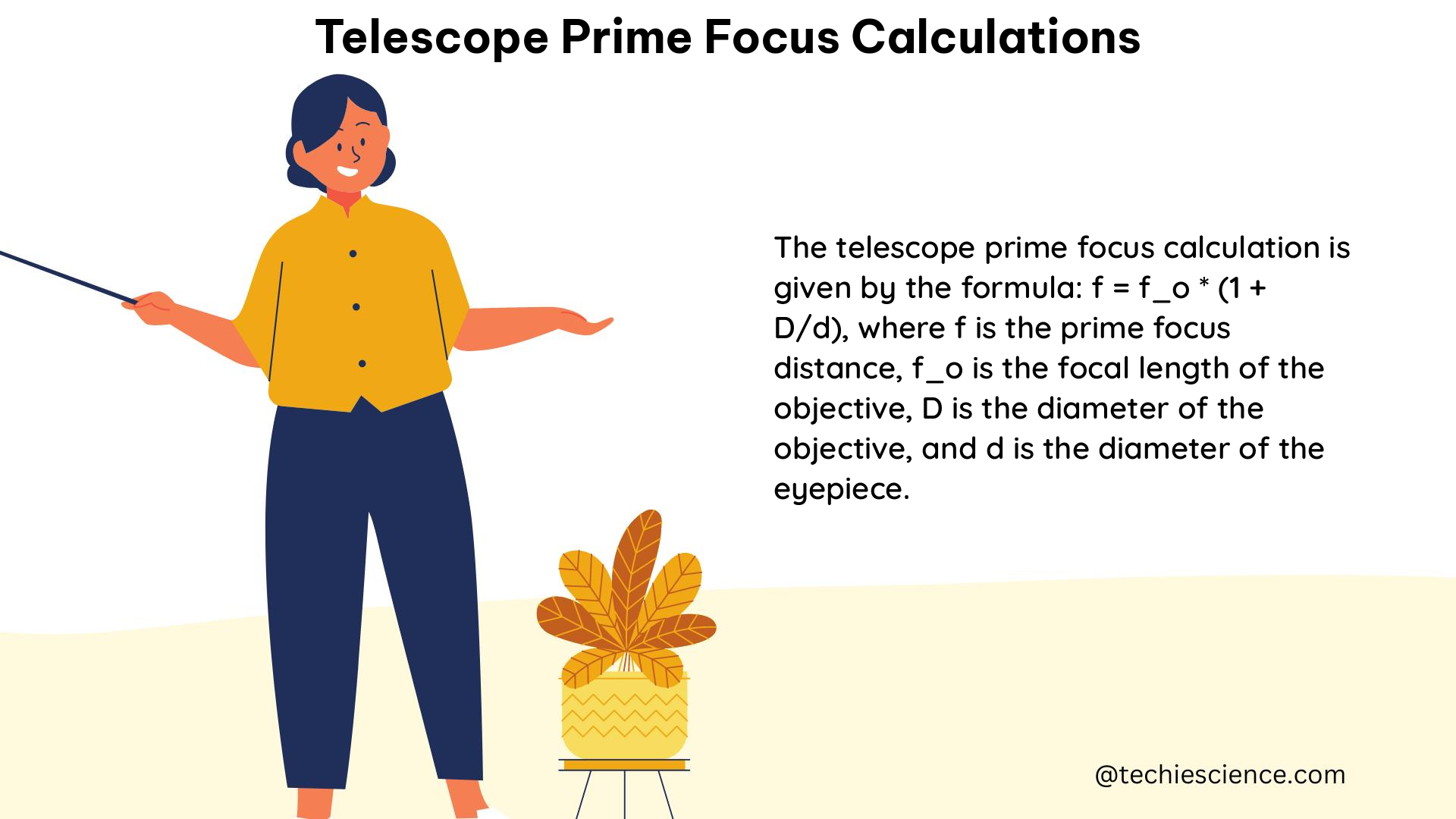Telescope prime focus calculations are essential for astrophotographers and astronomers to determine the magnification and field of view (FOV) of an image captured through a telescope. This comprehensive guide will provide you with the necessary formulas, examples, and additional resources to master these calculations.
Magnification Calculation
The magnification in prime focus can be calculated by dividing the focal length of the telescope by the diagonal size of the camera’s image plane. This method is applicable for film cameras but not for CCD or CMOS imaging, which have different pixel densities and sizes.
The formula for calculating magnification is:
$$Magnification = \frac{Focal\ Length\ of\ Telescope}{Diagonal\ Size\ of\ Camera’s\ Image\ Plane}$$
Example:
For a telescope with a focal length of 812 mm and a 35mm film camera (diagonal size of 43 mm), the magnification would be:
$$Magnification = \frac{812\ mm}{43\ mm} = 18.8X$$
Theorem:
The magnification of a telescope in prime focus is directly proportional to the focal length of the telescope and inversely proportional to the diagonal size of the camera’s image plane.
Physics Formula:
$$Magnification = \frac{f_t}{d_c}$$
Where:
– $f_t$ is the focal length of the telescope
– $d_c$ is the diagonal size of the camera’s image plane
Physics Example:
Suppose you have a Newtonian reflector telescope with a focal length of 1200 mm and you want to use a DSLR camera with a 22.3 mm x 14.9 mm APS-C sensor. The diagonal size of the camera’s image plane can be calculated as:
$$d_c = \sqrt{22.3^2 + 14.9^2} = 26.8\ mm$$
Plugging the values into the formula, the magnification would be:
$$Magnification = \frac{1200\ mm}{26.8\ mm} = 44.8X$$
Physics Numerical Problem:
A Cassegrain telescope has a focal length of 2000 mm. You want to use a full-frame DSLR camera with a 43.3 mm diagonal sensor size. Calculate the magnification in prime focus.
Given:
– Telescope focal length ($f_t$) = 2000 mm
– Camera diagonal sensor size ($d_c$) = 43.3 mm
Substituting the values in the formula:
$$Magnification = \frac{f_t}{d_c} = \frac{2000\ mm}{43.3\ mm} = 46.2X$$
Therefore, the magnification in prime focus for this setup is 46.2X.
Field of View (FOV) Calculation

The FOV can be calculated using the width and height of the camera chip in millimeters and the telescope’s focal length in millimeters. The formula is:
$$FOV\ (arc\ minutes) = \frac{Width\ of\ Camera\ Chip\ (mm) \times 3460}{Telescope\ Focal\ Length\ (mm)}$$
Example:
For an 8″ f/5 Newtonian telescope with a Canon 600D camera at prime focus, the FOV would be:
$$FOV\ (width) = \frac{22.3\ mm \times 3460}{1000\ mm} = 77.2\ arc\ minutes$$
$$FOV\ (height) = \frac{14.9\ mm \times 3460}{1000\ mm} = 51.5\ arc\ minutes$$
Theorem:
The field of view in prime focus is inversely proportional to the telescope’s focal length and directly proportional to the width and height of the camera chip.
Physics Formula:
$$FOV\ (arc\ minutes) = \frac{W_c \times 3460}{f_t}$$
Where:
– $W_c$ is the width of the camera chip in millimeters
– $f_t$ is the telescope’s focal length in millimeters
Physics Example:
Suppose you have a 6-inch f/8 Newtonian telescope and you want to use a Nikon D850 DSLR camera, which has a 35.9 mm x 23.9 mm full-frame sensor. The telescope’s focal length is 1200 mm.
To calculate the FOV, we can use the formula:
$$FOV\ (width) = \frac{35.9\ mm \times 3460}{1200\ mm} = 105.6\ arc\ minutes$$
$$FOV\ (height) = \frac{23.9\ mm \times 3460}{1200\ mm} = 70.3\ arc\ minutes$$
Physics Numerical Problem:
A Maksutov-Cassegrain telescope has a focal length of 1800 mm. You want to use a Canon EOS R5 camera, which has a 36 mm x 24 mm full-frame sensor. Calculate the field of view in prime focus.
Given:
– Telescope focal length ($f_t$) = 1800 mm
– Camera sensor width ($W_c$) = 36 mm
– Camera sensor height ($H_c$) = 24 mm
Substituting the values in the formula:
$$FOV\ (width) = \frac{36\ mm \times 3460}{1800\ mm} = 69.2\ arc\ minutes$$
$$FOV\ (height) = \frac{24\ mm \times 3460}{1800\ mm} = 46.1\ arc\ minutes$$
Therefore, the field of view in prime focus for this setup is 69.2 arc minutes in width and 46.1 arc minutes in height.
Additional Resources
- CCDCalc: A calculator that provides FOV, plate scale, and comparison images for various telescope and camera combinations. Link
- Astronomy Tools Calculator: A calculator for determining the focal length ratio and other parameters in afocal photography setups. Link
References
- Stargazers Lounge. (2007). Prime focus magnification – Imaging – Tips, Tricks and Techniques. Retrieved from https://stargazerslounge.com/topic/17114-prime-focus-magnification/
- Cloudy Nights. (2006). How to calculate the magnification in Prime Focus? Retrieved from https://www.cloudynights.com/topic/74646-how-to-calculate-the-magnification-in-prime-focus/
- UCF Pressbooks. (n.d.). 6.1 Telescopes – Astronomy. Retrieved from https://pressbooks.online.ucf.edu/astronomybc/chapter/6-1-telescopes/
- IceInSpace. (2019). FOV formula for Image at Prime Focus [Archive]. Retrieved from https://www.iceinspace.com.au/forum/archive/index.php/t-175218.html
- Reddit. (2022). How do I calculate magnification based on prime focus camera setup? Retrieved from https://www.reddit.com/r/AskAstrophotography/comments/uv1cxz/how_do_i_calculate_magnification_based_on_prime/?rdt=62334

The lambdageeks.com Core SME Team is a group of experienced subject matter experts from diverse scientific and technical fields including Physics, Chemistry, Technology,Electronics & Electrical Engineering, Automotive, Mechanical Engineering. Our team collaborates to create high-quality, well-researched articles on a wide range of science and technology topics for the lambdageeks.com website.
All Our Senior SME are having more than 7 Years of experience in the respective fields . They are either Working Industry Professionals or assocaited With different Universities. Refer Our Authors Page to get to know About our Core SMEs.